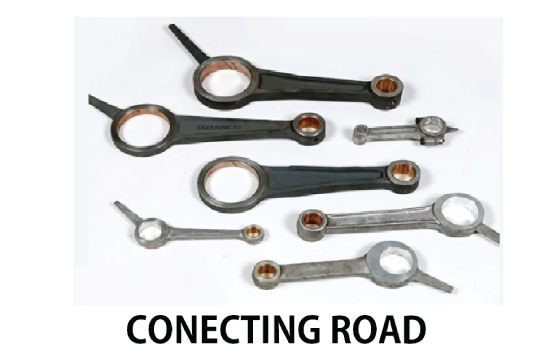-
Call
-
Whatsapp
9825014048
-
Location


Piston Compressor Connecting Rod
Piston Compressor Connecting Rod
Piston compressors, the workhorses of many industrial applications, rely on complex interconnections to produce compressed air efficiently. One of the most essential parts of this process is the connecting rod.
While usually overshadowed by the most apparent compressor parts, the connecting rod ensures reliable mechanical performance. In this comprehensive guide, we will explore the world of connecting lines in piston compressors, delving into their functions, types, materials, maintenance and their profound impact on compressor performance.
Piston compressors, also known as reciprocating compressors, work by using one or more pistons in a cylinder to compress air or air. The connecting rod is essentially a link between the piston and the crankshaft. It translates the linear motion of the piston into rotary motion, facilitating compression cycles.
Functions of the Connecting Rods
- Speed conversion: The connecting rod's main function is to convert the piston's parallel motion into rotation. This adjustment is important for driving the crankshaft and, consequently, the compressor's overall performance.
- Load distribution: The connecting rods uniformly distribute the loads generated during compression and extension to the crankshaft. This keeps the compressor running smoothly and efficiently.
- Precision Installation: Coupling bars perfectly align the piston and crankshaft, reducing friction and wear. Proper alignment is essential to ensure the compressor's longevity and efficiency.
- Lubrication Distribution: Connections in some compressors play a role in distributing the lubricating oil to the various components, ensuring proper efficiency and reducing friction.
Combinations of Different Materials
Piston compressors come in various combinations, each designed to suit specific compressor types and applications.
The Most Common Types Are:
- H-beam connecting rods: H-beam connecting rods have an H-shaped cross-section. They are known for their strength and are commonly used in high-performance compressors.
- I-beam connecting rods: I-beam connecting rods have an I-shaped cross-section and are widely used in industrial and automotive compressors. They provide a good balance of strength and weight.
- Forged Connector Rods: Forged connector rods are manufactured through the forging process, resulting in increased strength and durability. They are commonly used in heavy-duty compressors.
Connecting Cables
The selection of cable connections depends on factors such as compressor size, operating conditions, and intended use.
- Steel: Steel joints are known for their durability and durability. Suitable for high-pressure and heavy-duty applications.
- Aluminium: Aluminium connectors are lightweight and corrosion-resistant. They are typically used in small compressors and portable units.
- Titanium: Titanium connecting rods provide an excellent strength-to-weight ratio and corrosion resistance. They are used in high-performance compressors where weight reduction is required.
Repair and Maintenance
Proper maintenance and maintenance of the connecting cables is essential for correct and reliable operation of the compressor:
- Lubrication: Connecting rod bearing needs adequate lubrication to reduce friction and wear. Lubrication schedules should be diligently followed.
- Inspection: The connecting rod and its bearings should be inspected regularly for signs of wear or damage. Damaged or damaged items should be replaced immediately.
- Alignment: Proper alignment of the connecting rod is important to reduce friction and prevent premature wear. Negative rods should be reassembled if necessary.
- Heat Management: Proper heat management is essential to prevent overheating. Suitable cooling systems such as fans or cooling jackets should be installed.


FAQ

Frequently Ask Questions
A piston compressor connecting rod plays a crucial role in converting the reciprocating motion of the piston into rotational motion at the crankshaft. It connects the piston to the crankshaft and ensures proper transfer of power, allowing the compressor to operate efficiently.
Signs of a worn or damaged connecting rod include knocking noises during compressor operation, excessive vibration, or visible damage such as cracks or bends. Additionally, if there is a decrease in compressor performance or increased oil consumption, it may indicate a problem with the connecting rod. Regular inspection and maintenance can help identify issues early.
Connecting rods for piston compressors are typically made from high-strength materials such as steel or aluminum alloy. These materials offer the necessary durability and resistance to the stresses of compression and expansion cycles within the compressor. The choice of material may vary depending on factors such as compressor size, operating conditions, and desired longevity.

